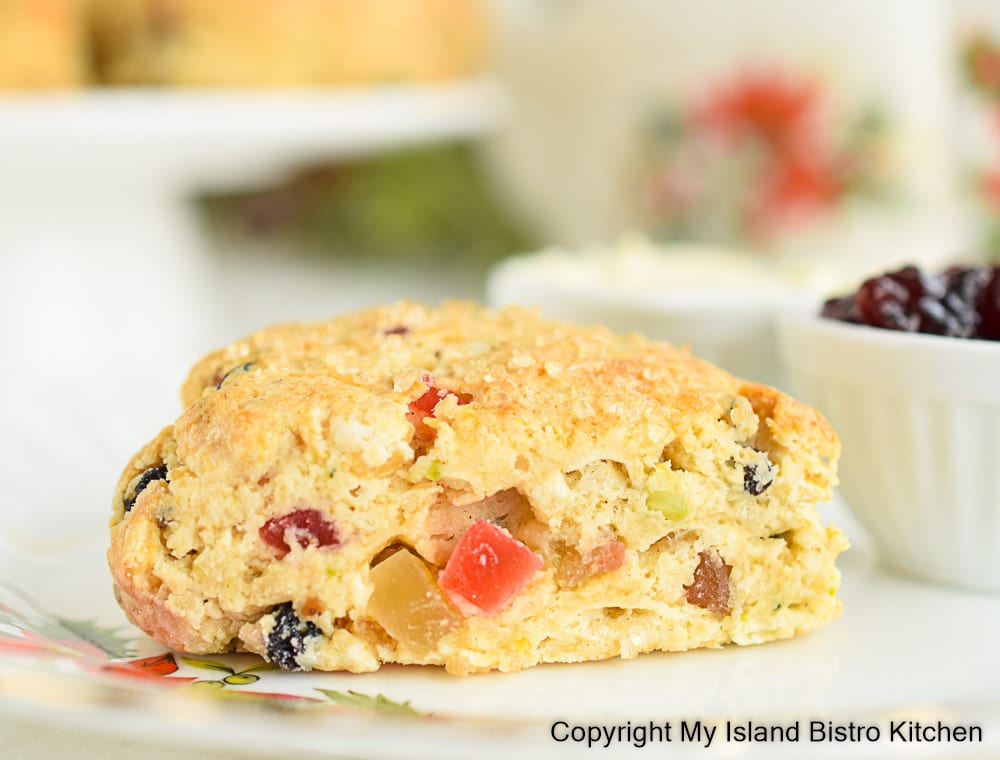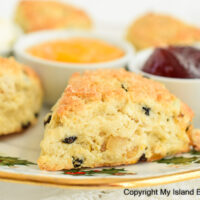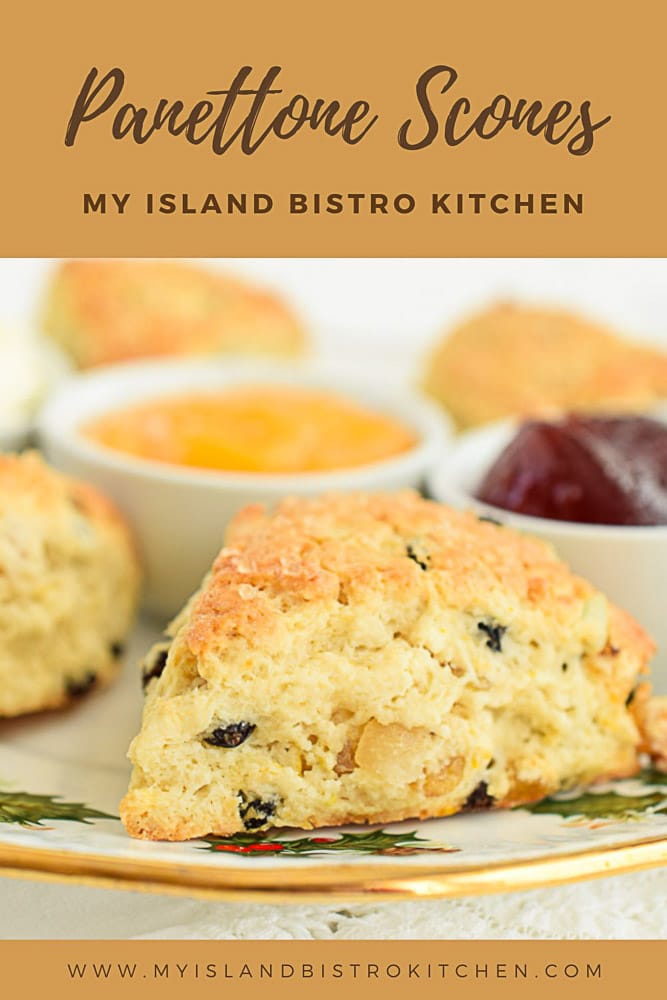
Inspired by the famous Italian sweet fruit bread/cake, these Panettone Scones (or, perhaps, more aptly “Panescone”) are divine served with clotted cream or English double cream, and your favorite fruit jam or curd. They are particularly tasty served with any of my homemade jams or jellies and either my clementine curd or cranberry curd.
I won’t go into a lot of detail in this posting about how to make scones. If you are unfamiliar with the procedure or need some hints and tips for making scones, please visit my tutorial posting on the subject by clicking here.
What classes these scones as Panettone Scones is the addition of raisins, currants, mixed candied peel, and nuts along with grated orange and lemon rind, common ingredients in Panettone.

I created this recipe using a blend of flours – all-purpose, sorghum, and almond flours. This is a lovely blend of flours I regular use in my baking, both in regular and gluten-free baking. The almond flour, in particular, gives a wonderful texture to the scones. If sorghum and almond flours are not flours you regularly use, and you choose to make this recipe, I recommend visiting your nearest bulk food store where flours can be bought in any amount needed. These are great sources from which to purchase small amounts of specialty flours (like sorghum and almond flours) when specifically called for in a recipe. This eliminates the need to buy an entire bag of each, especially if they aren’t flours you normally use.
I recommend rehydrating the currants to soften and plump them up. If the raisins are particularly dry or somewhat hard, rehydrate them with the currants in the hot orange juice. Simply add enough more orange juice to cover both the raisins and currants. Be sure to drain the raisins/currents well before adding them to the scone dough and discard the used orange juice.

Mixed dried fruit or mixed glazed fruit may be substituted for the candied lemon and orange peel called for in this recipe. However, it is important that, if using the mixed glazed fruit, it not be dripping in the glaze which would add too much liquid to the scones, potentially creating soggy or wet spots in the scones. Mixed dry fruit, if available, may thus be a better option. It is also important to note that heavy add-ins (e.g., mixed glazed fruit, candied peel, raisins, currants, nuts, etc.) incorporated into the scones may have an effect on their rising capability which is to say they may not rise to the usual puffy/lofty height of plain scones or ones containing only one add-in, for example.

That said, the colorful mixed fruit does result in a very colorful scone!

These Panettone scones are lovely to serve over the Christmas period but don’t reserve them just for the holidays – enjoy them year-round.

Panettone Scones
Ingredients:
1½ cups all-purpose flour
¼ cup superfine blanched almond flour
¼ cup sorghum flour
¼ cup granulated sugar
2¾ tsp baking powder
½ tsp salt
1/3 cup cold unsalted * butter, cut into ½“ cubes
2½ tsp finely grated orange zest
1½ tsp finely grated lemon zest
1/3 cup golden or sultana raisins (or a mix of both)
1/4 cup currants rehydrated and plumped in 2 tbsp hot orange juice then drained and any remaining juice discarded
1/3 cup candied lemon and orange peel (or substitute dried or glazed mixed fruit (see Note below)
2 -3 tbsp chopped almonds or pistachios (optional)
1 large egg (cold), lightly beaten with fork
½ cup whipping cream (cold) with ¾ tbsp removed and reserved for brushing tops of scones
¼ cup 2% milk (cold)
1 tsp pure vanilla extract
1/8 tsp pure almond extract
1 – 2 tsp granulated or turbinado sugar for sprinkling tops of scones (optional)
Method:
Rehydrate currants in hot orange juice in small bowl for 20-30 minutes. Drain well and discard any remaining orange juice. Set currants aside.
Line baking sheet with parchment paper.
In large bowl, sieve or sift the flours, sugar, baking powder, and salt together. Drop the cubes of butter into the dry ingredients and toss to coat the butter. Cut in the butter with a wire pastry cutter until mixture resembles coarse crumbs or pea-sized pieces. Quickly run fingers through the mixture several times, scooping up bits of the butter and rubbing them into long paper-thin slivers between the thumb and forefinger. It is not necessary to do this with every piece of butter – just quickly pick several at random.
Stir in the orange and lemon zest, raisins, drained currants, candied lemon and orange peel, and chopped almonds or pistachios (if using).
Make a well in the center of the dry ingredients.
In a small bowl or large measuring cup, lightly whisk the egg, whipping cream, milk, and vanilla and almond extracts together. Pour liquid ingredients all at once into well in center of dry ingredients. Using a fork, stir dough just enough that the liquid is absorbed into the dry ingredients and the dough can be roughly brought together. Dough will be soft and sticky and some floury spots may remain. Transfer dough onto lightly floured work surface, gently working it just until the dry ingredients are barely incorporated and a shaggy dough mass forms.
Fold the dough in half over onto itself. Lightly press the dough down. Turn the dough half turn and repeat the folding exercise. Repeat this 3-4 times. Shape dough loosely into a circular shape.
To make wedge-style scones: With a bench/pastry scraper or sharp knife, divide the dough into two equal parts. Lightly press and form each part into a small circle about ¾“ -1“ thick. Transfer to prepared baking sheet. Cut each circle into six equal wedges and separate the scones by about ¾”, still keeping each group of six wedges in a circular shape for baking. Refrigerate for 20 – 30 minutes.
Position oven rack in center of oven and preheat oven to 400°F.
Remove scones from refrigerator and, using a pastry brush, lightly brush the reserved whipping cream on tops of scones. Sprinkle with sugar.
To make round-shaped scones: Lightly press dough into circle about ¾ – 1“ thick. Use a lightly floured 1¾” – 2” round cutter to cut scones from dough. Push the cutter straight down and out of the dough without twisting the cutter in the process. Re-flour the cutter before cutting out each scone. Gather dough scraps and form into a circle from which to cut remaining scones, being careful to work the dough no more than absolutely necessary to bring it together. Transfer scones to prepared baking sheet, placing scones about 1” apart. Refrigerate for 20 – 30 minutes.
Position oven rack in center of oven and preheat oven to 400°F.
Remove scones from refrigerator and lightly brush the reserved whipping cream on tops of scones. Sprinkle with sugar.
To bake scones (wedge-shaped or round): Bake scones 15-17 minutes or until they are golden tanned. Rotate the baking sheet partway through the baking. Remove scones from oven and leave them on the baking sheet for 3-4 minutes before transferring them to a wire rack.
*salted butter may be substituted for the unsalted butter in which case, reduce the ½ teaspoon of salt called for in the recipe to ¼ teaspoon.
To serve: Serve warm scones along with clotted or English double cream and a favorite jam and/or curd. Or, simply enjoy with a good slather of butter on the scones.
Yield: 1 dozen wedge-shaped scones or apx 10 – 2” round scones (exact number will depend on size of cutter used and thickness of dough)
Note: Glazed mixed fruit may be substituted for the candied lemon and orange peel called for in this recipe. However, it is important that the mixed fruit not be dripping in the glaze which would add too much liquid to the scones, potentially creating soggy or wet spots in the scones. Mixed dry fruit, if available, may thus be a better option. It is also important to note that heavy add-ins (e.g., mixed glazed fruit, candied peel, raisins, currants, nuts, etc.) incorporated into the scones may have an effect on their rising capability which is to say they may not rise to the usual puffy/lofty height of plain scones or ones only containing one add-in, for example.
If you have made this recipe and enjoyed it and/or wish to share it with your friends and family, please do so on social media but be sure to share the direct link to this posting from my website.
Connect with My Island Bistro Kitchen on Social Media
Join the Facebook page for My Island Bistro Kitchen: https://www.facebook.com/MyIslandBistroKitchen/
Follow “the Bistro” on Twitter: https://twitter.com/PEIBistro/
See the drool-worthy gallery of mouth-watering food photos from My Island Bistro Kitchen on Instagram: https://www.instagram.com/peibistro/
Follow “the Bistro” on Pinterest at https://www.pinterest.ca/peibistro/ and pin the Pinterest-ready photo at the end of this posting to your favorite Pinterest boards!
You may also enjoy these other Scone recipes from My Island Bistro Kitchen:
Currant and Orange Scones
Gluten-free Scones
Cranberry and Lemon Scones
Pumpkin and Eggnog Scones

Panettone Scones
Ingredients
- 1½ cups all-purpose flour
- ¼ cup superfine blanched almond flour
- ¼ cup sorghum flour
- ¼ cup granulated sugar
- 2¾ tsp baking powder
- ½ tsp salt
- 1/3 cup cold unsalted * butter, cut into ½“ cubes
- 2½ tsp finely grated orange zest
- 1½ tsp finely grated lemon zest
- 1/3 cup golden or sultana raisins (or a mix of both)
- 1/3 cup candied lemon and orange peel (or dried or glazed mixed fruit (see Note below)
- ¼ cup currants rehydrated and plumped in 2 tbsp hot orange juice then drained and any remaining juice discarded
- 2 -3 tbsp chopped almonds or pistachios (optional)
- 1 large egg (cold), lightly beaten with fork
- ½ cup whipping cream (cold) with ¾ tbsp removed and reserved for brushing tops of scones
- ¼ cup 2% milk (cold)
- 1 tsp pure vanilla extract
- 1/8 tsp pure almond extract
- 1 – 2 tsp granulated or turbinado sugar for sprinkling tops of scones (optional)
Instructions
- Rehydrate currants in hot orange juice in small bowl for 20-30 minutes. Drain well and discard any remaining orange juice. Set currants aside.
- Line baking sheet with parchment paper.
- In large bowl, sieve or sift the flours, sugar, baking powder, and salt together. Drop the cubes of butter into the dry ingredients and toss to coat the butter. Cut in the butter with a wire pastry cutter until mixture resembles coarse crumbs or pea-sized pieces. Quickly run fingers through the mixture several times, scooping up bits of the butter and rubbing them into long paper-thin slivers between the thumb and forefinger. It is not necessary to do this with every piece of butter – just quickly pick several at random.
Stir in the orange and lemon zest, raisins, drained currants, candied lemon and orange peel, and chopped almonds or pistachios (if using).
- Make a well in the center of the dry ingredients.
- In a small bowl or large measuring cup, lightly whisk the egg, whipping cream, milk, and vanilla and almond extracts together. Pour liquid ingredients all at once into well in center of dry ingredients. Using a fork, stir dough just enough that the liquid is absorbed into the dry ingredients and the dough can be roughly brought together. Dough will be soft and sticky and some floury spots may remain. Transfer dough onto lightly floured work surface, gently working it just until the dry ingredients are barely incorporated and a shaggy dough mass forms.
Fold the dough in half over onto itself. Lightly press the dough down. Turn the dough a half turn and repeat the folding exercise. Repeat this 3-4 times. Shape dough loosely into a circular shape.
To make wedge-style scones:
- With a bench/pastry scraper or sharp knife, divide the dough into two equal parts. Lightly press and form each part into a small circle about ¾“ -1“ thick. Transfer to prepared baking sheet. Cut each circle into six equal wedges and separate the scones by about ¾”, still keeping each group of six wedges in a circular shape for baking. Refrigerate for 20 - 30 minutes.
- Position oven rack in center of oven and preheat oven to 400°F.
- Remove scones from refrigerator and, using a pastry brush, lightly brush the reserved whipping cream on tops of scones. Sprinkle with sugar.
To make round-shaped scones:
- Lightly press dough into circle about ¾ - 1“ thick. Use a lightly floured 1¾” – 2” round cutter to cut scones from dough. Push the cutter straight down and out of the dough without twisting the cutter in the process. Re-flour the cutter before cutting out each scone. Gather dough scraps and form into a circle from which to cut remaining scones, being careful to work the dough no more than absolutely necessary to bring it together. Transfer scones to prepared baking sheet, placing scones about 1” apart. Refrigerate for 20 - 30 minutes.
- Position oven rack in center of oven and preheat oven to 400°F.
- Remove scones from refrigerator and lightly brush the reserved whipping cream on tops of scones. Sprinkle with sugar.
To bake scones (wedge-shaped or round):
Bake scones 15-17 minutes or until they are golden tanned. Rotate the baking sheet partway through the baking. Remove scones from oven and leave them on the baking sheet for 3-4 minutes before transferring them to a wire rack.
Recipe Notes
To serve: Serve warm scones along with clotted or English double cream and a favorite jam and/or curd. Or, simply enjoy with a good slather of butter on the scones.
Yield: 1 dozen wedge-shaped scones or apx 10 – 2” round scones (exact number will depend on size of cutter used and thickness of dough)
Note 1: Salted butter may be substituted for the unsalted butter in which case, reduce the ½ teaspoon of salt called for in the recipe to ¼ teaspoon.
Note 2: Glazed mixed fruit may be substituted for the candied lemon and orange peel called for in this recipe. However, it is important that the mixed fruit not be dripping in the glaze which would add too much liquid to the scones, potentially creating soggy or wet spots in the scones. Mixed dry fruit, if available, may thus be a better option. It is also important to note that heavy add-ins (e.g., mixed glazed fruit, candied peel, raisins, currants, nuts, etc.) incorporated into the scones may have an effect on their rising capability which is to say they may not rise to the usual puffy/lofty height of plain scones or ones only containing one add-in, for example.
Copyright My Island Bistro Kitchen 2022
PIN ME TO PINTEREST!



